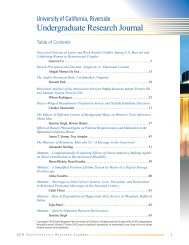UC Riverside Undergraduate Research Journal
UC Riverside Undergraduate Research Journal
UC Riverside Undergraduate Research Journal
You also want an ePaper? Increase the reach of your titles
YUMPU automatically turns print PDFs into web optimized ePapers that Google loves.
Computational Prediction of Association Free Energies for the C3d-CR2 Complex and Comparison to Experimental Data<br />
Alexander S. Cheung<br />
Introduction<br />
The immune system of higher vertebrates is made<br />
up of both innate and adaptive immunity [1]. The innate<br />
immune system functions primarily through the activity of<br />
leukocytes that indiscriminately work to rid the body of<br />
any foreign pathogenic substances. Activated by the innate<br />
immune system, the adaptive immune system is principally<br />
made up of memory B and T cells. These cells not only<br />
combat pathogenic threats, but also have the ability to<br />
remember specific pathogens and thus mobilize more<br />
rapidly and launch stronger attacks against the pathogen<br />
each time it is again encountered. By efficiently working<br />
together in concert, the innate and adaptive immune<br />
systems protect the body against disease.<br />
The complement system is a key component of<br />
innate immunity but also serves as a link between innate<br />
and adaptive immunities [2]. The complement system<br />
is activated through a complex cascade of catalytic<br />
reactions which involve cleavage of complement proteins<br />
into fragments and formation of protein complexes. The<br />
association of the d-fragment of complement component<br />
C3 (C3d), a globular serum protein, with complement<br />
receptor 2 (CR2), a modular B or T cell surface receptor,<br />
is a crucial link between the innate and adaptive immune<br />
systems. CR2 consists of 15 modules, called complement<br />
control protein (CCP) modules, of which only the first two<br />
modules, CCP1 and CCP2, are known to interact with C3d<br />
([3] and references therein). In this paper we investigate<br />
the interaction between C3d and the first two modules of<br />
CR2, herein referred to as CR2.<br />
There are numerous studies in literature that implicate<br />
charge and electrostatics as having a role in the interaction<br />
between C3d and CR2 [3-10]. It has been established that<br />
electrostatics are essential for many biological functions,<br />
including protein-ligand interactions [3-5], protein stability<br />
[4,11], catalysis [12], conformational transitions [13], and<br />
protein ionization [3-5,11-14]. In previous studies, the<br />
Morikis group has proposed that electrostatics drive C3d-<br />
CR2 recognition [3-5] and used the ionization properties<br />
of C3d and CR2 to demonstrate a correlation between<br />
ionization free energy differences, and association data<br />
from experimental mutagenesis studies [5]. Based on these<br />
studies, a two-step model for association was proposed,<br />
with the first step being recognition, and the second,<br />
binding [3-5,14]. According to this model, recognition<br />
is driven solely by long-range electrostatic interactions<br />
whereas binding involves long- and short/medium-range<br />
electrostatic interactions (including hydrogen bonds, salt<br />
bridges, and van der Waals forces) as well as short-range<br />
hydrophobic interactions and entropic effects. Recognition<br />
is responsible for the formation of a weak, nonspecific<br />
encounter complex, whereas binding is responsible for<br />
the formation of a strong and specific final complex.<br />
Conventional thinking dictates that only mutations at the<br />
binding interface should affect binding abilities. However,<br />
the study by Zhang et al [5] demonstrated that mutations<br />
remote from the association interface can also affect binding<br />
abilities (evaluated as ionization free energy differences),<br />
explaining controversial experimental data that previously<br />
seemed contradictory. This effect of distant mutations on<br />
association is possible only if recognition, as an initial step<br />
in association, involves electrostatic attraction between<br />
protein macrodipoles to form the encounter complex.<br />
Thus, the results of the study performed by Zhang et al [5]<br />
validated the two-step model for C3d-CR2 association.<br />
The goals of our study are to examine whether<br />
similar correlations exist between electrostatic free energies<br />
of association and relative binding ability as well as to<br />
evaluate the effect of solvation on the electrostatic free<br />
energies of association and examine whether correlations<br />
exist between solvation free energy differences and relative<br />
binding ability. We analyzed the effect of the same C3d<br />
and CR2 mutations as in the study by Zhang et al [5] on<br />
C3d-CR2 association. These are mutations for which there<br />
are published experimental data for C3d [9] and CR2 [6].<br />
Figure 1. Molecular representation of C3d-CR2 demonstrating the<br />
topology of the mutated amino acids. Basic and acidic amino acids<br />
are shown in blue and red, respectively. Glu116 was used as the<br />
contact amino acid in association interface and is colored in green.<br />
14 <strong>UC</strong>R Un d e r g r a d u a t e Re s e a r c h Jo u r n a l














